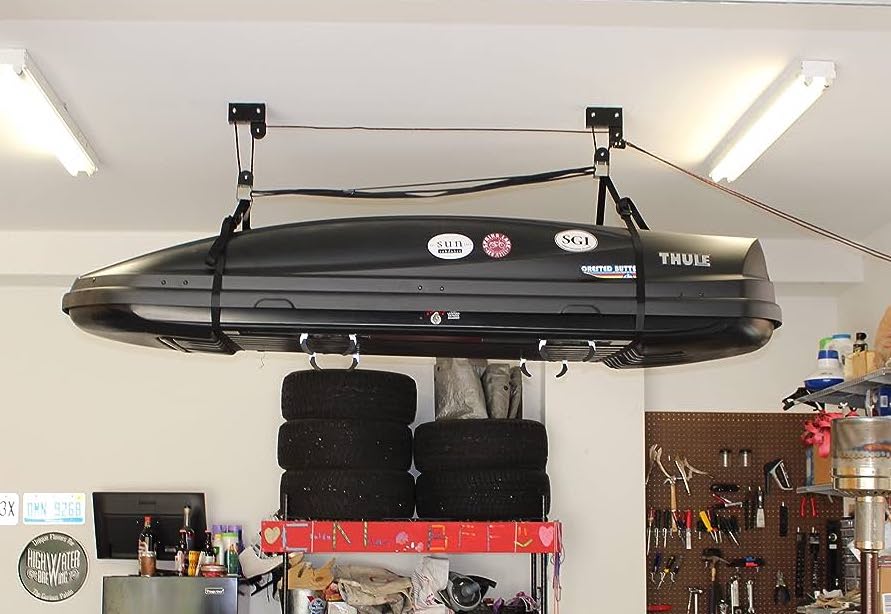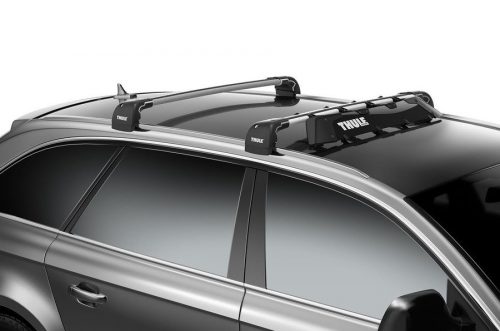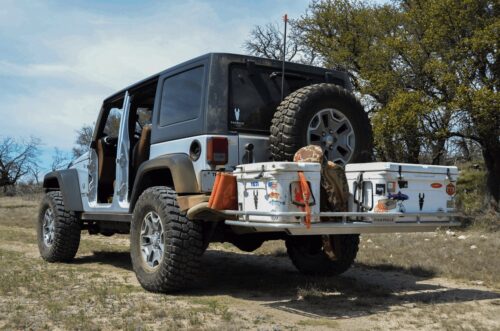Cargo racks have become a popular way of extending the loading capacity of a vehicle. They provide an effective and convenient platform for loading and transporting gear, luggage, and equipment on parts of your vehicle that may otherwise go underutilized when setting out on a journey. This article will examine common mistakes people make when buying or using a cargo box.
Mistake 1: Selecting the Wrong Cargo Rack
If you’re planning on increasing your cargo space with a rack, you essentially have the option of two places where you can mount a cargo rack on your vehicle:
- Roof Mounted Cargo Box or Bag
- Hitch-Mounted Cargo Rack


Both of these options have pros and cons. You must consider factors like storage capacity, accessibility, aerodynamics and fuel efficiency, vehicle height, towing capability, loading and unloading, and vehicle weight distribution to ensure you make a safe and practical choice for you and your car.
Your decision may also be impacted because you already use other carriers when traveling. For example, you may have a hitch bike rack installed, leaving only the roof of your car available for hauling cargo.
The choice between roof and hitch-mounted cargo carriers is a personal and subjective one that you should make after evaluating the factors above. Either way, once you’ve decided, be sure not to buy an inadequate or ill-fitting rack.
Mistake 2: Overloading the Cargo Rack
Every cargo carrier has a maximum weight capacity, and manufacturers will go to great pains to help you understand that. Before buying a rack, you must decide how much capacity you’d like to add to your vehicle.
It’s not only the rack’s weight capacity that should be considered but also that of the assembly point of the car. Ensure you understand how much weight your roof or the rails on your roof can carry. If you plan on buying a hitch-mounted carrier, familiarize yourself with the different hitch classes and tongue weights before making your final decision.
After ensuring the cargo rack isn’t overloaded, pay attention to proper weight distribution to maintain your rack’s stability and balance. Place heavy items at the bottom of the rack, evenly distribute the weight in the center, secure the load correctly, and test your final result by gently shaking your cargo carrier to check for shifting and movement before taking off.
Overloading a cargo carrier can damage your vehicle and the loss of cargo and is dangerous to you and other road users. Get this right. In the case of an accident, an overloaded cargo carrier will most likely void any insurance claim you would hope to have.
Mistake 3: Incorrect Installation
Incorrect cargo rack installation is one of the most common causes of cargo loss or vehicle damage, where drivers have opted for one of these platforms to haul their cargo. Following the manufacturer’s installation instructions and guidelines could have avoided most of these issues. It is that simple.
Pro Tip: Read the User Manual!
A good user manual should provide a simple step-by-step guide on properly installing your specific cargo rack model. Gather the required tools and follow the instructions. If you’re uncertain about something in the manual, reach out to customer service, or in many cases, a quick online search will solve your problem. Again, an incorrectly installed cargo rack may void any insurance claims in case of an accident.
Some common errors when installing a cargo rack include:
- Using incorrect or mismatched mounting hardware
- Not properly tightening or securing mounting bolts/clamps
- Installing the cargo rack in the wrong position on the vehicle
- Failing to align the cargo rack properly with the roof rack/crossbars or hitch receiver
- Neglecting to check for and correct any play or instability after installation
Make sure you get these right.
Mistake 4: Inadequate Securing of Cargo
Not properly securing cargo to the rack is the number one mistake and cause of losing gear or damaging your vehicle. In the worst cases, it can lead to road accidents and the loss of life. It is also one of the simplest mistakes to correct!
There are multiple options for securing your cargo to the rack; there’s no reason to be skimping on this and taking a chance. If you plan to tie your cargo down, use strong straps with ratchet or clamp attachments to tighten them.
Do NOT rely on hand-tied knots to secure your cargo.
Cargo nets are another great way of ensuring you tie down all your cargo as a whole and will, in most cases, prevent any losses due to shifting cargo. And, of course, if you want to keep it secure, safe, and tidy, invest in a cargo bag or cargo box. Place that on your cargo carrier, loud your gear and luggage, Close it up and secure it to the carrier.

Most cargo boxes and bags come with attachment points making that job much easier. This is the safest way of transporting your stuff on a cargo carrier and has the added benefit of protecting it against rain and dust while driving.
Finally, remember to stop occasionally on your journey to check whether everything is still in order. Ensure your cargo rack and cargo are still properly secured, and fix any issues you may spot immediately. Prevention is better than cure!
Mistake 5: Ignoring Vehicle Height Clearance
Cargo boxes are pretty low profile; in most cases, you should not have issues with your vehicle height clearance. A roof-mounted cargo basket can easily be loaded to heights exceeding the average clearance for garages and undercover parking lots. If you drive under a solid structure like the ones mentioned and your clearance is inadequate, you will damage your cargo carrier, load, and probably your car.
Here are a few simple steps to follow to calculate your overall vehicle height to avoid low-clearance structures:
- Determine the Vehicle’s Base Height
- Measure the Cargo Carrier’s Height
- Add the Vehicle’s Base Height and Cargo Carrier Height
- Account for Cargo Load (if applicable)
- Factor in Tire Pressure (if applicable)
- Be Conservative
Pro Tip: After calculating the overall vehicle height, mark it on the windshield to serve as a visible reminder, especially when approaching low-clearance areas.
Finally, before you set out on your journey, understand the vertical height clearance limitations of the route you plan to travel. Check for low bridges, underpasses, gates, and undercover parking areas. Ensure you will fit comfortably under all of these. If not, plan an alternative route or repack your cargo carrier.
Mistake 6: Neglecting Regular Maintenance
Once you start using a cargo rack, it will be subjected to a lot of movement weight and dynamic forces working in on the connection points and the structure. Ensuring your cargo box is safe is not a one-time job during installation only. It is an ongoing process. Periodic inspections, troubleshooting, and maintenance are essential.
Typical maintenance tasks would include regular checks for rust to ensure the structural integrity of your rack is intact. Check for loose nuts or bolts. There is a good chance some of them may loosen over time due to the vibrations from the road or the vehicle. Also, regularly check for any worn-out components on the rack. Most good manufacturers can replace or sell you individual parts of a rack system, so reach out when you spot a part that you feel has been compromised due to wear and tear.
Neglecting to take care of your cargo carrier will almost certainly reduce the longevity of your cargo rack, and you once again expose yourself to possible damage or accidents.
Mistake 7: Disregarding Traffic Laws and Regulations
There’s nothing worse than setting out on an adventurous weekend with your family to hear a dreaded Law Enforcement siren wailing you to pull over for some infringement. Additional laws and regulations must be followed to avoid this scenario if you use a cargo rack.
Traffic regulations about cargo carriers vary from state to state and often from county to county. Hence, the responsibility is to familiarize yourself with these rules before you set out on your trip.
The most common legal issues related to cargo rack usage typically fall under one of the topics below:
- Obstructing license plates or taillights
- Violating local traffic laws and regulations
- Exceeding weight limits set by law
- Not using proper reflective markings or lights for visibility
- Overhanging loads without proper flags or warning signs
- Blocking the driver’s view
- Failing to secure the cargo properly
- Carrying prohibited or hazardous materials without permits
- Overextending cargo beyond the vehicle’s dimensions without flags or lights
- Not complying with local height restrictions
Remember, you should comply with all local laws and regulations to avoid legal consequences or fines.
Mistake 8: Storing the Cargo Rack Improperly
Not storing your cargo rack properly while not in use can significantly reduce its longevity. Cargo racks are large and clumsy, making them challenging to store with limited space.
Roof-mounted cargo carriers can be left on the vehicle for prolonged periods, and if your car is parked in a garage at night, this may be your best option. Your carrier will, however, be exposed to the elements and normal wear-and-tear even though unloaded as you drive around every day.
If you uninstall and store your roof-mounted rack, consider a roof hoist or pulley system. Hoisting and extending your rack from your garage ceiling saves space and makes the refitment process much easier when you need to get it onto your car again.

If you have a hitch-mounted cargo carrier, you’ll probably have to remove and store it after every trip. Fortunately, removing a hitch-mounted rack is usually pretty simple. Find a safe, dry place for it in your garage or outbuilding and place it down as instructed in the user manual.
Regardless of where you store your cargo rack, ensure that it is not unnecessarily exposed to the elements, will not be damaged by vehicles or other heavy items, and is easy to place and collect whenever you want to use it. Dropping your cargo carrier while dragging it from an obscure storage spot can compromise the structural integrity or damage and break some rack components.
Final Word
Cargo racks are a great way of extending the loading capacity of your vehicle. If done correctly, this accessory can be used effectively and without any concerns about damage or loss to your property or the safety of yourself, your family, or other road users.
To do this, you must consider this article’s key considerations. By selecting the appropriate type of cargo rack for your needs, understanding weight capacities, installing the rack correctly, securing the cargo adequately, maintaining the rack regularly, and adhering to local traffic regulations, you can avoid potential pitfalls and maximize the benefits of your cargo rack.
Evaluating and addressing these aspects will safeguard your vehicle and belongings and enhance the driving experience. Whether embarking on a weekend getaway or a long road trip, a properly utilized cargo rack can make packing and transporting gear a breeze, freeing up valuable space inside the vehicle and ensuring a smooth and safe journey.
Willem is an avid mountain biker and outdoor sports enthusiast. For years, he has been riding mountain bike stage races, including the grueling Cape Epic. As a father of three adventurous kids, he knows about packing a vehicle to haul his gear safely and responsibly from home to any exciting weekend or holiday destination.







